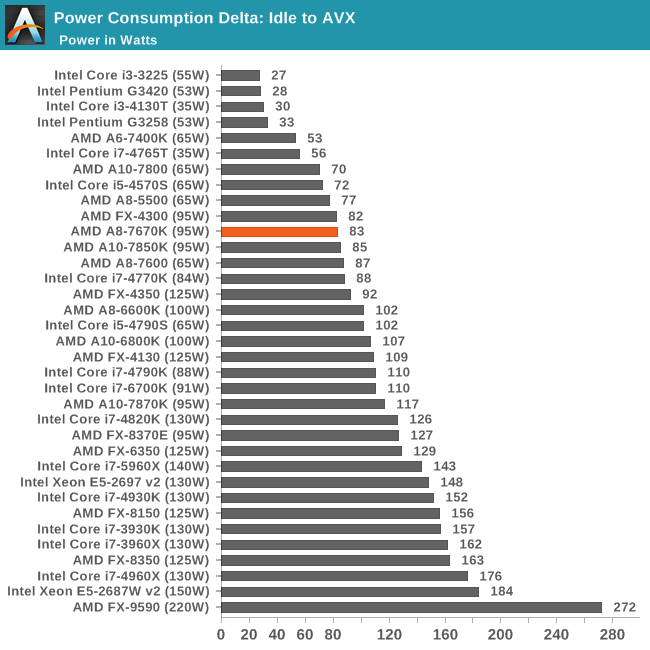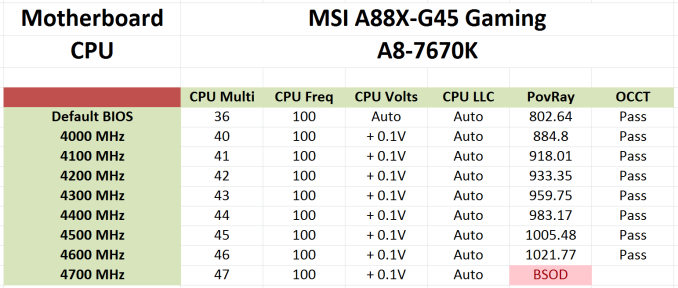The AMD A8-7670K APU Review: Aiming for Rocket League
by Ian Cutress on November 18, 2015 8:00 AM ESTThe Testing
A number of factors about the A8-7670K processor suggest that this is "another release of the same sort of stuff," albeit with increased frequencies. Nevertheless, we put the processor through our regular tests, to see what would happen. Our bench suite this time had one omission and one addition. For whatever reason, Linux Bench refused to run, with Ubuntu 14.04 throwing a hissy fit and not willing to start. I’m not sure if this was a BIOS issue or something more fundamental with the software stack, but it was odd. The addition, as the title of the review alluded to, is a Rocket League benchmark. At this time, we haven’t run it on many systems, but the A8-7670K is the sort of APU that enables games like Rocket League. Rocket League is a good contender for our 2016 CPU/APU benchmark suite on the integrated graphics side of things, and this serves as a good tester in the wild.
All of our regular benchmark results can also be found in our benchmark engine, Bench. Rocket League will be added in the future with the 2016 updates.
Test Setup
| Test Setup | |
| Processor | AMD A8-7670K 2 Modules, 4 Threads 3.6 GHz (3.9 GHz Turbo) R7 Integrated Graphics 384 SPs at 756 MHz |
| Motherboards | MSI A88X-G45 Gaming |
| Cooling | Cooler Master Nepton 140XL |
| Power Supply | OCZ 1250W Gold ZX Series Corsair AX1200i Platinum PSU |
| Memory | G.Skill 2x8 GB DDR3-2133 1.5V |
| Memory Settings | JEDEC |
| Video Cards | ASUS GTX 980 Strix 4GB MSI GTX 770 Lightning 2GB (1150/1202 Boost) ASUS R7 240 2GB |
| Hard Drive | Crucial MX200 1TB |
| Optical Drive | LG GH22NS50 |
| Case | Open Test Bed |
| Operating System | Windows 7 64-bit SP1 |
Many thanks to...
We must thank the following companies for kindly providing hardware for our test bed:
Thank you to AMD for providing us with the R9 290X 4GB GPUs.
Thank you to ASUS for providing us with GTX 980 Strix GPUs and the R7 240 DDR3 GPU.
Thank you to ASRock and ASUS for providing us with some IO testing kit.
Thank you to Cooler Master for providing us with Nepton 140XL CLCs.
Thank you to Corsair for providing us with an AX1200i PSU.
Thank you to Crucial for providing us with MX200 SSDs.
Thank you to G.Skill and Corsair for providing us with memory.
Thank you to MSI for providing us with the GTX 770 Lightning GPUs.
Thank you to OCZ for providing us with PSUs.
Thank you to Rosewill for providing us with PSUs and RK-9100 keyboards.
Load Delta Power Consumption
Power consumption was tested on the system while in a single GTX 770 configuration with a wall meter connected to the OCZ 1250W power supply. This power supply is Gold rated, and as I am in the U.K. on a 230-240 V supply, that leads to ~75% efficiency at greater than 50W, and 90%+ efficiency at 250W, suitable for both idle and multi-GPU loading. This method of power reading allows us to compare the power management of the UEFI and the board to supply components with power under load, and includes typical PSU losses due to efficiency.

The TDP for the A8-7670K is up at 95W, similar to many other AMD processors. However, at load, ours drew only an additional 83W, giving some headroom.
AMD A8-7670K Overclocking
For this review, we even tried our hand at overclocking on the MSI A88X-G45 Gaming motherboard and managed to get 4.6 GHz stable.
Methodology
Our standard overclocking methodology is as follows. We select the automatic overclock options and test for stability with POV-Ray and OCCT to simulate high-end workloads. These stability tests aim to catch any immediate causes for memory or CPU errors.
For manual overclocks, based on the information gathered from previous testing, we start off at a nominal voltage and CPU multiplier, and the multiplier is increased until the stability tests are failed. The CPU voltage is increased gradually until the stability tests are passed, and the process is repeated until the motherboard reduces the multiplier automatically (due to safety protocol) or the CPU temperature reaches a stupidly high level (100º C+, or 212º F). Our test bed is not in a case, which should push overclocks higher with fresher (cooler) air.
Overclock Results
MSI’s motherboard doesn’t allow fixed voltages to be set but prefers to rely on an offset system only. There is a problem here that we are also fighting a DVFS implementation, which will automatically raise the voltage when an overclock is applied, with an end result of stacking the overclock voltage offset on top of the DVFS voltage boost. On our cooling system, the processor passed quite easily up to 4.6 GHz without much issue, but 4.7 GHz produced an instant blue screen when a rendering workload was applied. Hitting 4.6 GHz on a midrange AMD processor is quite good, indicating our sample is some nice silicon, but your mileage might vary.











154 Comments
View All Comments
Drumsticks - Wednesday, November 18, 2015 - link
If AMD really could get a 40% single threaded performance boost on their CPUs for Zen, and they can do it no later than Kaby Lake, then they really might get a moment to breath. That puts single threaded performance right around Intel's i3 parts, and would put multi-threaded performance (and likely graphics although that's a different story) well ahead. It's not going to take back the desktop market overnight, but it would be enough to get PC builders and maybe some OEMs interested and get enough volume moving for them to survive.Even if we budget a 10% IPC boost for Intel in Kaby Lake, that puts their i3's barely ahead, and still probably significantly behind in multi threaded performance compared to a 4 core Zen part. Here's hoping for an AMD recovery! I'd love to recommend AMD parts in more than just the $300 region now. Even if Zen only gets a single OEM to genuinely notice AMD, it will be an improvement.
V900 - Wednesday, November 18, 2015 - link
You seriously think AMD is going to sell a 4 core Zen processor for the same amount that a dual core Intel i3 sells for?In that case I got a bridge to sell you!
Make no mistake, AMD doesn't sell cheap APUs out of the goodness of their hearts.
The reason they're the budget option is because they don't have anything remotely competitive with Intel's Core CPUs, and therefore only can compete on the very low end of the market.
If their Zen core turns out to be on par with an intel processor, they'll sell it at the prices Intel charges, or slightly lower.
You won't see a quadcore Zen selling for roughly the same price Intel charges for an I3. You'll have AMD selling their quadcore Zen for the same 300$ Intel charges for an i5
yankeeDDL - Wednesday, November 18, 2015 - link
I don't fully agree.Yes, AMD's IPC is much lower than Intel's, and there's a gap in energy efficiency (although, much reduced with Carrizo).
But, as you correctly indicate, AMD prices they chip accordingly. So at ~120usd, the A8/A10 are extremely attractive, in my opinion. For home users, which have the PC on on a relatively small fraction of the time, having more cores, and an excellent GPU (compared to intel's at those price point) is quite beneficial.
Skylake changes things a bit, but up to Haswell (included) the performance of Intel's Core i3 in the low $100s, was easily beaten.
Dirk_Funk - Wednesday, November 18, 2015 - link
I don't think he/she said a single word about how zen would be priced. I don't know why you responded this way. Also, i5 sells for like $200-$250.Aspiring Techie - Wednesday, November 18, 2015 - link
If Zen is as good as advertised, then AMD can afford to increase the price of their CPUs by 20%. This would make their quad-cores in the $130-150 range, way cheaper than Intel's i5s. Granted, even Zen won't be as good as Kaby Lake. If AMD's performance per clock is 60% of Intel's, then Zen's will be about 84% of Intel's. Add in that a much better power efficiency (because the microarchitecture will have fewer pipeline stages) and possibly more cache with the smaller process node and you get roughly 85% i5 performance for $30 less. This doesn't even consider their APUs, which still could be priced at near i3 levels. They would beat the crap out of i3s and sometimes i5s (if HSA is utilized).Bottom line: Zen is AMD's last chance. AMD probably won't make the stupid mistake of pricing their CPU's too high. If they do, then bye-bye AMD for good.
JoeMonco - Wednesday, November 18, 2015 - link
"Bottom line: Zen is AMD's last chance. AMD probably won't make the stupid mistake of pricing their CPU's too high. If they do, then bye-bye AMD for good."Because if AMD is known for anything it's for its great business decisions. rofl
medi03 - Thursday, November 19, 2015 - link
Yeah, that's why they are in both major consoles at the moment, because of the "bad" business decisions.Klimax - Thursday, November 19, 2015 - link
There's a reason why Intel was uninterested in consoles. AMD barely makes any money on them...Kutark - Thursday, November 19, 2015 - link
^ This. Being in the consoles is because it was a massive volume order of parts and MS and Sony are looking to save as much as possible, fractions of a dollar per part matter when you're paying for literally millions of parts.anubis44 - Sunday, November 29, 2015 - link
The consoles are still providing AMD with a solid, baseline income every year, and their presence in consoles also make games easier to port to AMD's architecture, something that will become more apparent with DX12, since consoles are already using a DX12/Mantle-like API. AMD's decision to sweep the consoles and push Intel and nVidia out of them will have longer term reprocussions than many realize. AMD is also almost certain to win the next generation of consoles, too, with Zen-based APUs and Greenland-type graphics with HBM. In fact, AMD will probably release something like that for the mainstream PC market by 2017 and nVidia will be relegated to only the high-end of add-in graphics: AMD will be putting solidly mainstream graphics into their APUs, and an add-in mainstream AMD card will simply crossfire with the built-in graphics.